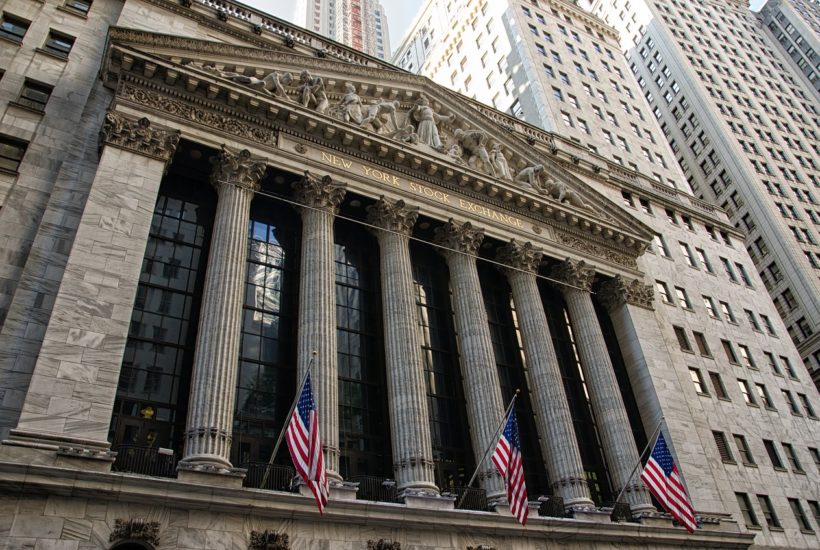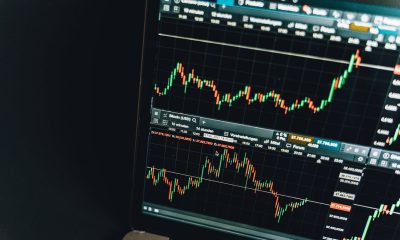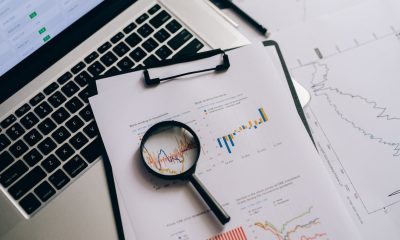Business
Fiscal and Monetary Cliffs Have Arrived
When you factor in the massive fiscal and monetary cliffs together with the most overvalued stock market in history, you have the recipe for potential unprecedented stock market chaos, which should be front-end loaded in ‘22. If your retirement savings is with a deep state of Wall Street firm, you hold some mix of stocks and bonds that is set on autopilot. Their fate should be the same as the Hindenburg and Titanic.

According to Doug Ramsey of the Leuthold Group, 334 companies trading on the New York Stock Exchange recently hit a 52-week low, more than double the amount that marked new one-year highs. That’s happened only three other times in history — all of them occurring in December 1999.
How did we get back to the precipice of the year 2000, where tech stocks plunged 80% and the S&P 500 lost 50% of its value over the ensuing two years? Well, start off with the fact that the amount of new money created by our central bank in the past 14 years is $8 trillion. That, by the way, is an increase in base money supply only and does not include all of the new money created by our debt-based monetary system. So, from 1913 to 2008, the Fed created $800 billion. And, it took from 2008 until today—just 14 years–for it to have created $8.8 trillion in base money supply. Is there really any wonder why inflation has now become a salient issue, especially for the middle and lower classes, and why the stock market is now set up for a meltdown similar to the NASDAQ collapse of two decades ago?
Some might claim that the bubble in the stock market was much different in 2000 than it is today. They are correct. The overvaluation 22 years ago pales in comparison to today. With its record high P/S ratio of 3.5, as opposed to just 1.8 back in 2000. And the mind-numbing record-high 210% TMC/GDP ratio, which is an incredible 68 percentage points ahead of where it ascended to 22 years ago.
Ok, so the stock market is much more expensive today than at any other time in history, but what will the catalyst be to set it tumbling off the cliff? Last week I talked about the monetary cliff coming in the next two months. To review: The Fed will wind down its record-breaking $120 billion per month counterfeiting scheme to zero dollars in that timeframe. This Q.E. involved the process of handing newly created money to banks, consumers, and businesses to boost consumption. But by ending this flow of new money, the Fed will also end its tacit support for the municipal bond market, primary dealers, money market mutual funds, REPO market, International SWAP lines, ETF market, primary and secondary corporate debt markets, commercial paper market, and support for student, auto and credit card loans. All of which were directly supported by Jerome Powell’s with the Fed’s latest Q.E. program.
But it doesn’t end there. Mr. Powell cannot be content with just ending Q.E., not with CPI running at 6.8%! Therefore, very soon after Q.E. is terminated, interest rates are heading higher, and the balance sheet of the Fed must start shrinking. However, an occasional 25-bps rate hike here or there won’t cut it. He has to hike rates by 680-bps just to get to a zero percent real Fed Funds Rate. Now, of course, Powell doesn’t intend to hike monetary policy that much because he is fully aware it would collapse the whole artificial market construct well before he gets anywhere close to that level. But the point here is that the FOMC has lost the luxury of being able to delay and dither as it has in the past because inflation is running at a 40-year high. Hence, the Fed will need to hike rates rather aggressively until inflation, the economy, or asset prices come crashing down. But since all three are so closely linked together, they will likely all cascade simultaneously.
And, now this week, I want to shed some new light on the concurrent fiscal cliff and shoot a hole through Wall Street’s excess savings B.S. As most of you are already aware, I’ve been pretty clear about the negative consumption effects that will result from the ending of $6 trillion in government handouts over the previous two years. This massive and unprecedented largess caused the savings rate in the U.S. to jump from 7.8% in January 2020 to 33.8% by April of the same year. However, that savings rate has now collapsed back down to 6.9%—below its pre-pandemic level. But what about the stash of savings consumers are sitting on that is supposed to carry GDP ever-higher this year?
Well, it appears that the rainy day fund is dwindling quickly. According to the N.Y. Times and Moody’s Analytics, the excess savings among many working- and middle-class households could be exhausted as soon as early 2022. This would not only reduce their financial cushions but also potentially affect the economy since consumer spending has risen to become nearly 70% of GDP.
We have already seen multiple pandemic-era federal aid programs expire last September, including the massive federal supplement to unemployment benefits. Now, with the Expanded Child Income tax credit having expired, which gave up to $300 per child under 6, and up to $250 per child ages 7 to 17 over the period from July to December, the fiscal challenges have become salient for many Americans.
But what about that pile of savings? Estimates are that it now amounts to around $2.0 trillion (8.5% of GDP). It’s mostly in the hands of the very rich, who are savers and have a much lower marginal propensity to consume than those in the middle and lower classes. According to a study from Oxford Economics, 80% of that savings is in the hands of the top 20% of earners, and 42% went to the top 1%. Again, this is important because it is the middle and lower classes that are responsible for the majority of consumption. So, how is this economically-crucial cohort doing? Well, in addition to getting hurt by inflation and falling real wages, they are running out of their stimulus hoard quickly. According to a recent study done by JP Morgan Chase, households making $68,896 per year or less only have an extra $517 in their checking accounts on average compared with their pre-pandemic level. As unimpressive as that sounds, add in the fact that people don’t eat into their savings with the same zeal that they spend a fresh government handout, and you can see that so-called “mountain of savings” Wall Street loves to tout isn’t much more than a molehill.
When you factor in the massive fiscal and monetary cliffs together with the most overvalued stock market in history, you have the recipe for potential unprecedented stock market chaos, which should be front-end loaded in ‘22. If your retirement savings is with a deep state of Wall Street firm, you hold some mix of stocks and bonds that is set on autopilot. Their fate should be the same as the Hindenburg and Titanic.
__
(Featured Image by USA-Reiseblogger via Pixabay)
DISCLAIMER: This article was written by a third party contributor and does not reflect the opinion of Born2Invest, its management, staff or its associates. Please review our disclaimer for more information.
This article may include forward-looking statements. These forward-looking statements generally are identified by the words “believe,” “project,” “estimate,” “become,” “plan,” “will,” and similar expressions. These forward-looking statements involve known and unknown risks as well as uncertainties, including those discussed in the following cautionary statements and elsewhere in this article and on this site. Although the Company may believe that its expectations are based on reasonable assumptions, the actual results that the Company may achieve may differ materially from any forward-looking statements, which reflect the opinions of the management of the Company only as of the date hereof. Additionally, please make sure to read these important disclosures.

-

 Africa2 weeks ago
Africa2 weeks agoForeign Investor Activity in Morocco’s Equity Market in 2024
-

 Fintech2 days ago
Fintech2 days agoPayPal Under Fire: Excessive Data Collection and Privacy Concerns in Advertising
-

 Biotech1 week ago
Biotech1 week agoJohnson & Johnson’s Tecvayli Combo Shows Breakthrough Results in Multiple Myeloma
-

 Cannabis4 days ago
Cannabis4 days agoTrump Signals Historic Shift: U.S. Weighs Reclassifying Cannabis from Schedule I to III






![RDE, Inc. [NASDAQ: RSTN] hits the Nasdaq](https://born2invest.com/wp-content/uploads/2024/08/rde-inc-hits-the-nasdaq-400x240.jpg)
![RDE, Inc. [NASDAQ: RSTN] hits the Nasdaq](https://born2invest.com/wp-content/uploads/2024/08/rde-inc-hits-the-nasdaq-80x80.jpg)

















